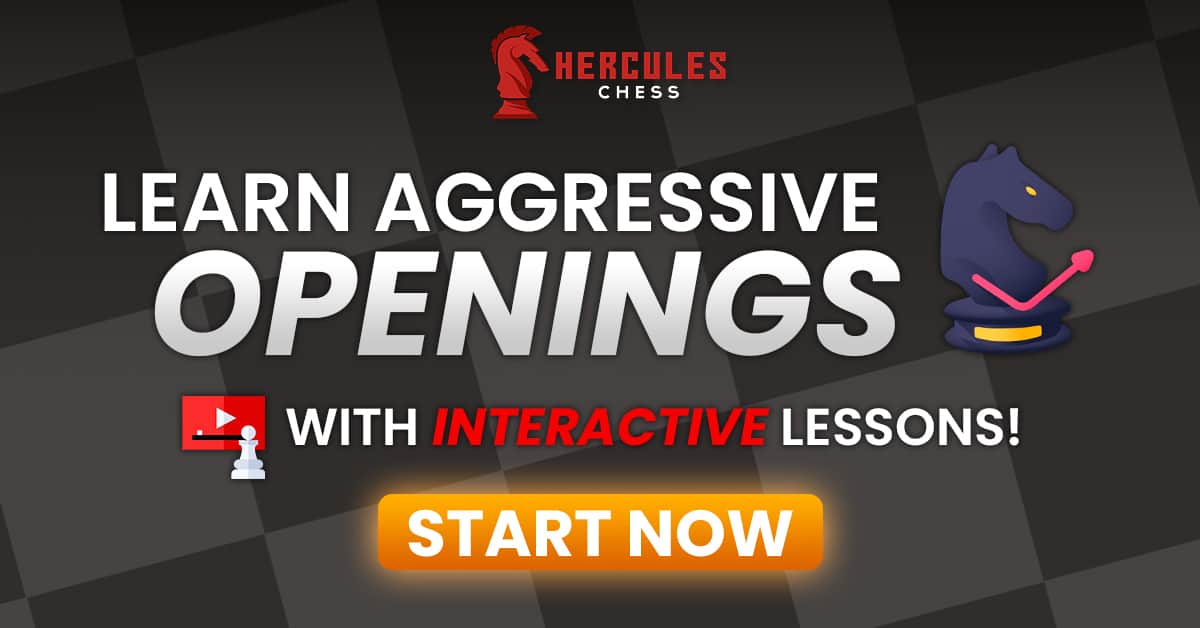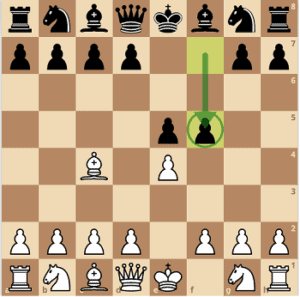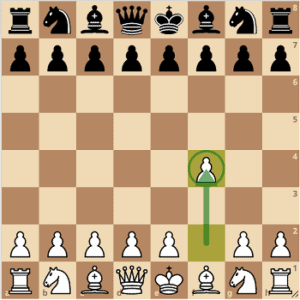Playing strategically and aggressively in chess is what makes the game royal and beautiful. Once you make the right opening moves, you and your opponent can begin unfolding new approaches. Soon, the “real chess game” begins and both of you will inevitably be hooked. There are several aggressive chess openings for white that can allow you to finish the game quickly. We’ve compiled a list of them.
Everyone loves to study the theory behind opening moves and learn new strategies and techniques that will pave the way to victory. However, the middle game is where players either win or give up.
End-game strategies are quite straightforward; you either win or lose. Many chess players give up before they reach the end. Reading on, you will surely learn successful new tactics and strategies in the opening. This is an important area of chess.
Without having an idea of basic opening strategies, you won’t be able to win. At this point, there is so much information that comes your way, and playing the game can leave you overwhelmed. With that said, let’s take a look at 9 aggressive chess openings for White plus the strategies and ideas behind them.

The Vienna Game

The Vienna game commences after 1.e5 e5 2.Nc3. This strategy is a fundamentally sound chess opening. The Vienna Game follows the majority of central opening principles and enables significant creativity for both non-aggressive and aggressive players.
There are three options for black to respond to the Vienna Game strategy. These options are: 2.Nf6, 2.Bc5, and 2.Nc6. Every black response paves the way for white to select how to move the game forward. White has the option of leading a quiet game by simply developing minor pieces towards the middle, opting to stay ahead in space and time.
White also has the option of moving to f4, playing the gambit, and transposing it into different King’s Gambit lines. For players who enjoy playing the Three Knights Game, the Halloween Gambit, the King’s Gambit, or simply prefer a different move than Ruy Lopes, this opening is best for them. The Vienna Game is easy to learn and offers plenty of options, which the opponent isn’t prepared for.
The Smith Morra Gambit

1.e4 c5 2.d4 is the beginning of the Smith Morra Gambit. This strategy is an aggressive and sharp line against black’s Sicilian Defense. If you play white and make an e4 move for any length of time, then you are bound to encounter the Sicilian Defense many times.
This gambit is best only for players who prefer to play aggressively (just like with the majority of gambits). White aims to not just take out black from the normal Sicilian lines, but also to use its development advantage to overwhelm the black king.
White typically aims to put its bishop on c4 to attack the weak f7 pawn, focusing on the castled kingside, once its knight is on f3. Eventually, white aims to place its rooks on the semi-open d file and the open c file. Afterward, white would have various potential attacking lines at its disposal. The black player must play very carefully. Various Sicilian defenders end up playing the Smith-Morra Gambit.
The Scotch Game

The Scotch opening starts out with 1.e4 e5 2.Nf3 Nc6 3.d4! This is a strategy that has regained popularity recently, as numerous top players have started using the Scotch Game as a way of surprising their opponent (who is more likely prepared to face Ruy Lopez).
This strategy is like the Center Game strategy, in which d4 opens lines for development and also offers white center control early on. In the Scotch Game, black has an option to develop easily, while white must aim to take advantage of its special center control. Chess players who prefer playing 1.e4 must learn the Scotch Game since there are various subtle traps in which black can fall into which would give the white player an overwhelming advantage.
The majority of players would expect white to play 3.Bc4 or 3.Bb5. However, when white incorporates the Scotch Game by making a different move, 3.d4, the opponent is bound to make some amateur mistake, which would open the door for the white player to take better control of the game.
It is essential for the black player to learn the Scotch Game to better understand and recognize different lines and spot the one that best fits your playing style. This strategy is an opening in which if you aren’t prepared can lead you towards trouble quite early on in the game. This is the reason it is essential to learn concepts of the Scotch Game.
The Calabrese Counter Gambit

This opening starts out with 1.e4 e5 2.Bc4 f5?! White uses the Italian strategy in hopes of quickly developing its light-squared bishop and dominating the center. Black uses the Calabrese Counter Gambit strategy to give up its f pawn to thwart white’s entire game plan.
The more aggressive attempts or moves white makes in the opening, the more traps it may potentially fall into. Black typically ends up with powerful center control, whilst white pieces struggle to locate good squares to develop on. The white player has to be very careful and precise or it can get into trouble. If you play black and want a powerful attack, then the Calabrese Counter Gambit is the right strategy for you.
The Bird’s Opening

The Bird Opening begins with the unexpected move 1.f4. This offensive strategy has been ranked the 6th most popular opening; it is pretty aggressive. White begins by weakening its kingside and initiates a flack attack with its f pawn on the center. The Bird’s Opening is infrequently utilized at the top levels.
However, a few great games in chess history have used this opening. Once black defends with a d5 move, the game starts to transpose itself in a reverse Dutch Defense; in which white’s opening move is d4 and black’s response is f5.
The main focus is on the dark squares, which makes a major difference compared with the typical light squares that a white player generally focuses on. Whilst white’s main minor piece is the light-squared bishop, in the Bird’s Opening, a nod is given to the dark-squared bishop. White typically fianchettoes its bishop towards the queenside to b2 and places extra pressure on the dark squares.
The Lay Down Sacrifice
This offensive strategy is another dangerous attacking weapon in chess. During non-master games, this strong move is hardly ever seen. The main aim of the sacrifice is prying open defensive protection in front of the enemy king. This strategy is most effective when your opponent is forced to accept the material.
It is essential to avoid situations in which your opponent has the option of leaving a piece hanging and ignoring your gift. In such a scenario, this move would probably fall under the Hope Chess category. You must create a situation in which your opponent has no choice but to accept your sacrifice so that you can achieve an advantage.
The King’s Gambit

The starting of the King’s Gambit is 1.e4 e5 2.f4?! This offensive strategy is one of the oldest chess openings, for a good reason. The possibilities offered by this opening have intrigued some of the greatest chess minds, including Fischer, Tal, and Spassky. White challenges black’s center control in the second movement and starts attacking black kingside.
Black has the option to decline or accept the gambit. The majority of black players prefer to accept this gambit and try to counterattack white’s now semi-exposed kingside.
If black accepts the gambit, white must focus all of its attention on the f7 square, which becomes black’s biggest weakness. After the move 2 exf4, white has two ideal options. One option is to start attacking immediately with 3.Bc4 to instantly pressure the f7 square.
The second option for white is 3.Nf3. This will help defend against 3 Qh4+ and start to develop a kingside attack. The best thing about the King’s Gambit is that it is rather unpredictable. If the opponent isn’t familiar with the correct defense, they will soon get into trouble. The majority of the games are open with dynamic and exciting lines. If you are a creative player and prefer using wild sacrifices and exotic combinations, the King’s Gambit is an ideal opening for you.
The Italian Game or Giuoco Piano

The Italian game is one of the most common chess openings for white and it begins with the moves: 1.e4 e5 2.Nf3 Nc4 3.Bc4. In the history of chess, this is probably one of the oldest ever recorded game openings. It is said that these moves were developed by chess players, such as Polerio and Damiano around the 16th century. It was further improved by Greco (1962), who gave this strategy its main theme.
For more than 300 years now, this strategy has been analyzed extensively. People sometimes refer to it as Giuoco Piano. However, this term particularly refers to the play after a player moves the bishop to c5.
This opening is slightly different. Most chess grandmasters never prefer it, because it can lead to a draw (if not played well). However, this opening is considered a good one and helps to develop pieces. If the white player moves its pawn from e2 to e4, a possible move for the black will be to move its pawn from e7 to e5.
If black moves its knight from b8 to c6, the Italian move is characterized by the white player moving their bishop to c4 (as opposed to b5). The opponent will then move their bishop from f8 to c5. The best play for white will now be to move their white pawn from c2 to c3 to be able to continue the game in a proper manner.
The player can then move their knight to f6, which will make it easier to attack the opponent’s e4 pawn. The white player will then move their pawn to d4, and the black player will continue with kingside castling.
Ruy Lopez

The Ruy Lopez is a chess opening for white that is highly theoretical and begins with the moves: 1.e4 e5 2.Nf3 Nc6 3.Bb5. This opening strategy is also known as the “Spanish opening in chess.” The Ruy Lopez strategy is quite simple and straightforward, just like the previously discussed strategy. This strategy doesn’t require much brainpower. It is so common that you will see it in friendly games or tournaments.
Imagine that you are playing a match against your friend. You play the white pieces, and your opponent takes the black ones. Basic moves happen, like the white pawn (you) will move to e4 and the black pawn (your opponent) moves to e5.
Next, you will move your knight to f3, and the black knight will respond by moving to c6. Further, you, as the white player, will pin down the black knight with your bishop; this move puts the knight in danger of being captured (as well as the pawn at e5).
The most common response by black is to move their pawn to a6. This move is done to try and divert the bishop from attacking the knight. However, as the white player, you have two options, to either attack the knight, or retreat. In case you decide to attack the black knight, the opponent will still capture the bishop with his/her pawn.

Another move you can make is to keep the bishop because we all know it has many distinct capabilities. You could pull the bishop back to c4 or a4. At this point, it is advised that you should retreat with the bishop to a4 for two reasons.
- It will keep the bishop safe from the black pawn’s attack; and
- It pins your bishop to the knight you were initially targeting at the start of the game.
With such a move, the opponent will have to think carefully about other pawns and the knight. Instead, he/she will move his/her pawn to b5. The white player will then move the bishop back to b3. This is also a good position because it allows the bishop to target the opponent’s f7 pawn. With this move, if the opponent decides to move the pawn from a6 to try and capture the white bishop, the white player can equally capture the black pawn with his/her pawn to a3.
However, the black player will try to move the bishop to f6. After this, the black player will be able to capture the white player’s pawn on e5. In this situation, you should decide to go for kingside castling, because if the knight captures the pawn, then with the castling, your rook and queen can move out to control the center and get ready to attack the opponent.
Once you move the king, you can move your knight and capture the opponent’s pawn on e5. Their king will be in “check.” This is a very good situation for the white player. This is a common way of playing the Ruy Lopez opening. From this move, the opponent will likely move their bishop to e7, and then castle. You can then continue to attack the black pieces.
This tactic at times seems boring, but if you master the moves, then surely you will be able to make better middle-game moves. So far, with these moves, you must have noticed that none of your white pieces have been captured.
Conclusion – Aggressive Chess Openings For White
As white, you may find a lot of attacking chances as early in the opening. Beginners are encouraged to develop their aggressive style in chess by taking risks and breaking the opponent’s opening preparation.
1.e4 is a great opening move for white because it gives white more attacking chances which leads to dynamic and aggressive play. Although aggressive openings may seem dubious and underrated by some elite players, master them well, and you may easily win most of your games in record time.
Related Post: 3 basic keys to chess strategy






